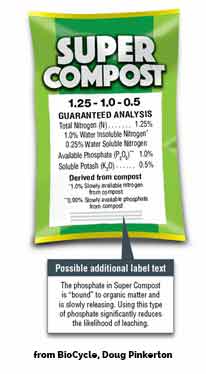Compost for Erosion Control
Print this Article | Send to Colleague
 Compost and Phosphorous Claims - A new testing method and labeling guidelines have been approved to enable producers of compost, and other carbon-based products to measure and advertise the amount of slowly releasing phosphate in their products, if their products are registered as fertilizers (making legal nutrient content claims). This can be done by testing composts for their content of "water extractable phosphorous” (WEP). Compost, and other carbon-based products, typically possess less WEP; therefore, the phosphate from these products is more likely to stay where it was applied, rather than run off into nearby waters.
Compost and Phosphorous Claims - A new testing method and labeling guidelines have been approved to enable producers of compost, and other carbon-based products to measure and advertise the amount of slowly releasing phosphate in their products, if their products are registered as fertilizers (making legal nutrient content claims). This can be done by testing composts for their content of "water extractable phosphorous” (WEP). Compost, and other carbon-based products, typically possess less WEP; therefore, the phosphate from these products is more likely to stay where it was applied, rather than run off into nearby waters.
At the July 2021 American Association of Plant Food Control Officials (AAPFCO) meeting, the SERA-17 test method for WEP was found to be acceptable and at the February 2022 meeting the WEP definition became ‘official. The final piece of this puzzle involved illustrating how testing for the WEP content could be used to make labeling claims on carbon-based products. State control officials were concerned that using the term WEP on the label would create confusion, because fertilizer phosphorus is expressed as "available phosphate." Therefore, WEP testing will instead be used to illustrate "slowly available phosphate" on a label, like the way slowly available nitrogen is claimed.
This strategy enables the new phosphate claims to align more closely with existing labeling regulations and formats. (See label graphic below)
In the near-term, compost manufacturers can use this option as follows:
- If their compost is already registered as a fertilizer, they can test for WEP and make a new claim.
- If they are selling or distributing their product to farmers, turf managers and other end users because of its nutrient content, this additional test data could assist them in better helping customers manage any additional nutrients that may need to be applied along with their the biosolids product.
- It could allow compost manufacturers to better defend the application of their products where environmental concerns exist, related to nutrient addition.
Thank you to the composters who supported this process.
Compost for Erosion Control - many State's Departments of Transportation, the US Environmental Protection Agencies and the American Association of State Highway Transportation Highway Officials (AASHTO) specify that compost be used for soil erosion and sediment control on highway projects. AASHTO first published erosion control specifications for compost blankets and filter berms in 2003, and later for compost filter socks. AASHTO designates the compost blanket spec as R 52-10 (2019) and the filter berm and sock spec as R 51-13 (2017). Through efforts of Ron Alexander (original author) and Dr. Britt Faucette, the three specs have been upgraded, and are expect to be publicly available in July.
Modifications to the specs were related to allowable compost characteristic tolerances, including pH (reduced), electrical conductivity (expanded), stability (reduced) and physical contaminants (reduced). Modifications were made to better address plant growth, composter and end user requirements.
Ron Alexander is president of R. Alexander Associates, Inc. (Apex, North Carolina, www.alexassoc.net), a company specializing in product and market development for organic recycled products. He is a horticulturist and longtime member of the USCC and its Market Development Committee. He is also the author of national landscaping and erosion control specifications for compost and is an Industry Liaison to the Association of American Plant Food Control Officials.


